Overview of Seniority Isomers
Abstract
1. Introduction
2. Quasi-Spin Algebra: Single-j and Multi-j
- A quasi-spin scalar if is odd.
- component of the quasi-spin vector if is even.
3. Seniority (and Generalized Seniority) Isomers: Where and Why?
4. Seniority Isomers in Various Mass Regions
4.1. Ca Isotopes
4.2. Ni Isotopes
4.3. Sn Isotopes
4.4. Pb Isotopes
4.5. N = 28 Isotones
4.6. N = 50 Isotones
4.7. N = 82 Isotones
4.8. N = 126 Isotones
4.9. Cd and Te Isotopes
4.10. Hg and Po Isotopes
4.11. N = 48 and N = 52 Isotones
4.12. N = 80 and N = 84 Isotones
4.13. N = 124 and N = 128 Isotones
5. Predictions and Open Issues
- The measurement gaps in the systematics of seniority isomers require special attention from the experimentalists, since this missing piece of information would be crucial for the theoretical developments. The presence of isomers in neutron-rich Pd and Cd, for example, strongly suggests the same isomers in more neutron-rich Ru and Mo, isotonic nuclei. Similarly, future experimental data on the isomer in neutron-rich Ru (due to two neutron holes in ) will be immensely helpful in understanding the function of pairing in such a limiting and exceedingly neutron-rich nucleus. The existence of isomers in Cd also suggests the dominance of the neutron configuration for the lower lying state. Any information on the state due to two proton holes in Cd would be equally important for assessing the competitiveness between proton and neutron two-body configurations. Similar investigation for the states in Pd would also be encouraging to understand the structural evolution.
- The particle-number independent variation of the magnetic moments for the good (generalized) seniority states can be used to predict the g-factors for the gaps in measurements. For example, the g-factor for the isomer in Ca should be in the similar order to the g-factor of the isomer in Ca. Despite the fact that the two states in Ca have different seniorities, the g-factor should be equal to neutron owing to the pure-j configuration. Similarly, the g-factor in Ni isotopes for the isomers should be comparable and, if measured, would represent the nature of the implicated neutron orbital. The same can be said for the states in Ni isotopes, which are not isomeric due to the additional and permitted decay branch. Similar would be true for the seniority isomers in medium to heavy mass nuclei such as the isomers in Sn isotopes, the isomers in Pb, and lighter Pb isotopes. The same is true for the g-factors of seniority isomers in various isotonic chains.
- If the isomers have the same origin and only differ in terms of an extra odd-particle, the g-factor of odd-A isomers will be in the same order as that of even-A isomers for a given isotopic or isotonic chain. The g-factor for the isomers in odd-A Sn isotopes, for example, would be of the same order as the isomers in even-A Sn isotopes. The same will hold true for the odd-A isomers in lighter odd-A Pb isotopes due to their similarity to the neighboring even-A isomers. Similarly, the g-factor for the and isomers in respective even-A , and odd-A , isotones should be almost equal to each other. The Schmidt value for proton is n.m., although the GSSM estimate for the mixed proton configuration is +1.27 n.m. Such future moment measurements would provide the complete understanding of a nuclear structure for these isotonic isomers.
- To address the similarities and differences in the behavior of states in Cd, Sn and Te isotopes, the Q-moment measurements in heavier Te isotopes are of current experimental interest, particularly when similar measurements for Cd and Sn isotopes are now known with great precision at the ISOLDE facility [81,115]. Since the states are found to occur quite regularly in Cd, Sn and Te isotopes for the range of , one can expect the higher seniority isomers such as , , in the Cd and Te isotopes, similar to the Sn isotopes.
- The lack of experimental data on E2 decay properties of the first states below the seniority isomers in isotones prevents a conclusion on the seniority conservation in from being established. Similarly, in other heavier mass regions, firm E2 assignments below the most-aligned seniority isomer are not yet available. The E2 properties for the states below the neutron-rich seniority isomers in Sn isotopes beyond Sn and the states below the seniority isomers in Pb isotopes beyond Pb, for example, will undoubtedly contribute to realistic and effective nuclear shell model interactions. To fully comprehend the neutron–neutron/proton–proton as well as neutron–proton two-body matrix elements, comprehensive spectroscopic information for isomers and states below isomers in two-particles/holes nuclei with respect to semi-magic nuclei such as Cd and Te isotopes, Hg and Po isotopes, , 52 isotones, , 84 isotones, , 128 isotones is necessary.
6. Conclusions
Author Contributions
Funding
Data Availability Statement
Acknowledgments
Conflicts of Interest
References
- Jain, A.K.; Maheshwari, B.; Goel, A. Nuclear Isomers-A Primer; Springer Nature: Cham, Switzerland, 2021. [Google Scholar]
- Garg, S.; Maheshwari, B.; Singh, B.; Sun, Y.; Goel, A.; Jain, A.K. Atlas of Nuclear Isomers-Atomic Data and Nuclear Data Tables, 2nd ed.; Elsevier: Amsterdam, The Netherlands, 2022. [Google Scholar]
- Walker, P.M.; Podolyák, Z. Nuclear Isomers. In Handbook of Nuclear Physics; Tanihata, I., Toki, H., Kajino, T., Eds.; Springer: Singapore, 2022; pp. 1–37. [Google Scholar]
- Racah, G. Theory of Complex Spectra. III. Phys. Rev. 1943, 63, 367–382. [Google Scholar] [CrossRef]
- Flowers, B.H. Studies in jj-Coupling. 1st Classification of Nuclear and Atomic States. Proc. R. Soc. Lond. A 1952, 212, 248–263. [Google Scholar]
- Racah, G. Nuclear Levels and Casimir Operator. Memorial; Farkas, L., Ed.; Research Council of Israel: Jerusalem, Israel, 1952; pp. 294–304. [Google Scholar]
- Talmi, I. Simple Models of Complex Nuclei, 1st ed.; Harwood Academic Publishers: London, UK, 1993. [Google Scholar]
- Rowe, D.J.; Wood, J.L. Fundamentals of Nuclear Models-Foundational Models; World Scientific Publishing: Singapore, 2010. [Google Scholar]
- Kota, V.K.B.; Devi, Y.D. Nuclear Shell Model and the Interacting Boson Model: Lecture Notes for Practitioners; Inter University Consortium for DAE Facilities: Calcutta Centre, India, 1996. [Google Scholar]
- Casten, R.F. Nuclear Structure from a Simple Perspective; Oxford University Press: New York, NY, USA, 2000. [Google Scholar]
- Lawson, R.D. Theory of the Nuclear Shell Model; Oxford University Press: New York, NY, USA, 1980. [Google Scholar]
- Heyde, K.L.G. Basic Ideas and Concepts in Nuclear Physics; CRC Press: Boca Raton, FL, USA, 2004. [Google Scholar]
- Isacker, P.V.; Heinze, S. Partial Conservation of Seniority and Nuclear Isomerism. Phys. Rev. Lett. 2008, 100, 052501. [Google Scholar] [CrossRef] [PubMed]
- Parikh, J.C. Group Symmetries in Nuclear Structure; Springer: New York, NY, USA, 1978. [Google Scholar]
- Esuderos, A.; Zamick, L. Seniority conservation and seniority violation in the g9/2 shell. Phys. Rev. C 2006, 73, 044302. [Google Scholar] [CrossRef]
- Qi, C. Partial conservation of seniority in the j = 9/2 shell: Analytic and numerical studies. Phys. Rev. C 2011, 83, 014307. [Google Scholar] [CrossRef]
- Isacker, P.V. Seniority Isomers in Nuclei. J. Phys. Conf. Ser. 2011, 322, 012003. [Google Scholar] [CrossRef]
- Maheshwari, B.; Jain, A.K. Odd tensor electric transitions in high-spin Sn-isomers and generalized seniority. Phys. Lett. B 2016, 753, 122–125. [Google Scholar] [CrossRef]
- Lanford, W.A. Seniority for nucleons in j = 9/2 orbits. Phys. Lett. B 1969, 30, 213–215. [Google Scholar] [CrossRef]
- Sawicka, M.; Grzywacz, R.; Matea, I.; Grawe, H.; Pfützner, M.; Daugas, J.M.; Lewitowicz, M.; Balabanski, D.L.; Becker, F.; Bélier, G.; et al. Low energy levels in 72Ni. Phys. Rev. C 2003, 68, 044304. [Google Scholar] [CrossRef]
- Jungclaus, A.; Caceres, L.; Gorska, M.; Pfutzner, M.; Pietri, S.; Werner-Malento, E.; Grawe, H.; Langanke, K.; Martínez-Pinedo, G.; Nowacki, F.; et al. Observation of Isomeric Decays in the r-Process Waiting-Point Nucleus 130Cd82. Phys. Rev. Lett. 2007, 99, 132501. [Google Scholar] [CrossRef]
- Ressler, J.J.; Beausang, C.W.; Casten, R.F.; Zamfir, N.V.; Ai, H.; Amro, H.; Babilon, M.; Cakirli, R.B.; Caggiano, J.A.; Gürdal, G.; et al. Isomers and seniority in the trans-Pb nuclei. J. Phys. G Nucl. Part. Phys. 2005, 31, S1605–S1610. [Google Scholar] [CrossRef]
- Lozeva, R.L.; Simpson, G.S.; Grawe, H.; Neyens, G.; Atanasova, L.A.; Balabanski, D.L.; Bazzacco, D.; Becker, F.; Bednarczyk, P.; Benzoni, G.; et al. New sub-μs isomers in 125,127,129Sn and isomer systematics of 124–130Sn. Phys. Rev. C 2008, 77, 064313. [Google Scholar] [CrossRef]
- Pietri, S.; Jungclaus, A.; Górska, M.; Grawe, H.; Pfützner, M.; Cáceres, L.; Detistov, P.; Lalkovski, S.; Modamio, V.; Podolyák, Z.; et al. First observation of the decay of a 15- seniority v = 4 isomer in 128Sn. Phys. Rev. C 2011, 83, 044328. [Google Scholar] [CrossRef]
- Watanabe, H.; Lorusso, G.; Nishimura, S.; Xu, Z.Y.; Sumikama, T.; Söderström, P.A.; Doornenbal, P.; Browne, F.; Gey, G.; Jung, H.S.; et al. Isomers in 128Pd and 126Pd: Evidence for a Robust Shell Closure at the Neutron Magic Number 82 in Exotic Palladium Isotopes. Phys. Rev. Lett. 2013, 111, 152501. [Google Scholar] [CrossRef]
- Gottardo, A.; Valiente-Dobón, J.J.; Benzoni, G.; Nicolini, R.; Gadea, A.; Lunardi, S.; Boutachkov, P.; Bruce, A.M.; Górska, M.; Grebosz, J.; et al. New Isomers in the Full Seniority Scheme of Neutron-Rich Lead Isotopes: The Role of Effective Three-Body Forces. Phys. Rev. Lett. 2012, 109, 162502. [Google Scholar] [CrossRef] [PubMed]
- Simpson, G.S.; Gey, G.; Jungclaus, A.; Taprogge, J.; Nishimura, S.; Sieja, K.; Doornenbal, P.; Lorusso, G.; Söderström, P.-A.; Sumikama, T.; et al. Yrast 6+ Seniority Isomers of 136,138Sn. Phys. Rev. Lett. 2014, 113, 132502. [Google Scholar] [CrossRef]
- Astier, A. High-seniority states in spherical nuclei: Triple pair breaking in tin isotopes. J. Phys. Conf. Ser. 2013, 420, 012055. [Google Scholar] [CrossRef]
- Astier, A.; Porquet, M.-G.; Theisen, C.; Verney, D.; Deloncle, I.; Houry, M.; Lucas, R.; Azaiez, F.; Barreau, G.; Curien, D.; et al. High-spin states with seniority v = 4, 5, and 6 in 119–126Sn. Phys. Rev. C 2012, 85, 054316. [Google Scholar] [CrossRef]
- Iskra, Ł.W.; Broda, R.; Janssens, R.V.F.; Wrzesiński, J.; Szpak, B.; Chiara, C.J.; Carpenter, M.P.; Fornal, B.; Hoteling, N.; Kondev, F.G.; et al. Higher-seniority excitations in even neutron-rich Sn isotopes. Phys. Rev. C 2014, 89, 044324. [Google Scholar] [CrossRef]
- Maheshwari, B.; Jain, A.K.; Srivastava, P.C. 6+ isomers in neutron-rich Sn isotopes beyond N = 82 and effective interactions. Phys. Rev. C 2015, 91, 024321. [Google Scholar] [CrossRef]
- Maheshwari, B.; Jain, A.K.; Singh, B. Asymmetric behavior of the B(E2↑;0+→2+)values in 104–130Sn and generalized seniority. Nucl. Phys. A 2016, 952, 62–69. [Google Scholar] [CrossRef]
- Maheshwari, B.; Garg, S.; Jain, A.K. Δv = 2 seniority changing transitions in yrast 3- states and B(E3) systematics of Sn isotopes. Pramana-J. Phys. Rapid Commun. 2017, 89, 75. [Google Scholar] [CrossRef][Green Version]
- Kota, V.K.B. Multiple Multi-Orbit Fermionic and Bosonic Pairing and Rotational SU(3) Algebras. Bulg. J. Phys. 2017, 44, 454–465. [Google Scholar]
- Jain, A.K.; Maheshwari, B. Goodness of Generalized Seniority in Semi-magic Nuclei. Nucl. Phys. Rev. 2017, 34, 73–81. [Google Scholar]
- Maheshwari, B.; Jain, A.K. Generalized seniority Schmidt model and the g-factors in semi-magic nuclei. Nucl. Phys. A 2019, 986, 232–244. [Google Scholar] [CrossRef]
- Maheshwari, B.; Kassim, H.A.; Yusof, N.; Jain, A.K. Evolution of nuclear structure in and around Z = 50 closed shell: Generalized seniority in Cd, Sn and Te isotopes. Nucl. Phys. A 2019, 992, 121619. [Google Scholar] [CrossRef]
- Maheshwari, B.; Choudhury, D.; Jain, A.K. Generalized seniority isomers in and around Z = 82 closed shell: A survey of Hg, Pb and Po isotopes. Nucl. Phys. A 2021, 1014, 122277. [Google Scholar] [CrossRef]
- Maheshwari, B.; Choudhury, D.; Jain, A.K. Puzzle on isomeric configurations in and around N = 126 closed shell. Phys. Rev. C 2022, 105, 024315. [Google Scholar] [CrossRef]
- Gorska, M. Trends in the Structure of Nuclei near 100Sn. Physics 2022, 4, 364–382. [Google Scholar] [CrossRef]
- Grawe, H.; Straub, K.; Faestermann, T.; Górska, M.; Hinke, C.; Krücken, R.; Nowacki, F.; Böhmer, M.; Boutachkov, P.; Geissel, H.; et al. The (6+) isomer in 102Sn revisited: Neutron and proton effective charges close to the double shell closure. Phys. Lett. B 2021, 820, 136591. [Google Scholar] [CrossRef]
- Jain, A.K.; Maheshwari, B. Generalized seniority states and isomers in tin isotopes. Phys. Scr. 2017, 92, 074004. [Google Scholar] [CrossRef]
- Valiente-Dobón, J.J.; Gottardo, A.; Benzoni, G.; Gadea, A.; Lunardi, S.; Algora, A.; de Angelis, G.; Bazzacco, D.; Benlliure, J.; Boutachkov, P.; et al. Manifestation of the Berry phase in the atomic nucleus 213Pb. Phys. Lett. B 2021, 816, 136183. [Google Scholar] [CrossRef]
- Iskra, W.; Broda, R.; Janssens, R.V.F.; Chiara, C.J.; Carpenter, M.P.; Fornal, B.; Hoteling, N.; Kondev, F.G.; Królas, W.; Lauritsen, T.; et al. Shell-model states with seniority v = 3, 5, and 7 in odd-A neutron-rich Sn isotopes. Phys. Rev. C 2016, 93, 014303. [Google Scholar] [CrossRef]
- Togashi, T.; Tsunoda, Y.; Otsuka, T.; Shimizu, N.; Honma, M. Novel Shape Evolution in Sn Isotopes from Magic Numbers 50 to 82. Phys. Rev. Lett. 2018, 121, 062501. [Google Scholar] [CrossRef]
- Morales, I.O.; Isacker, P.V.; Talmi, I. Generalized seniority and E2 transitions in the tin isotopes. Phys. Lett. B 2011, 703, 606–608. [Google Scholar] [CrossRef]
- Corsi, A.; Obertelli, A.; Doornenbal, P.; Nowacki, F.; Sagawa, H.; Tanimura, Y.; Aoi, N.; Baba, H.; Bednarczyk, P.; Boissinot, S.; et al. Spectroscopy of nuclei around 100Sn populated via two-neutron knockout reactions. Phys. Rev. C 2018, 97, 044321. [Google Scholar] [CrossRef]
- Kerman, A.K. Pairing forces and nuclear collective motion. Ann. Phys. 1961, 12, 300–329. [Google Scholar] [CrossRef]
- Kerman, A.K.; Lawson, R.D.; Macfarlane, M.H. Accuracy of the superconductivity approximation for pairing forces in nuclei. Phys. Rev. 1961, 124, 162–167. [Google Scholar] [CrossRef]
- Helmers, K. Symplectic invariants and flowers’ classification of shell model states. Nucl. Phys. 1961, 23, 594–611. [Google Scholar] [CrossRef]
- Arima, A.; Ichimura, M. Quasi-Spin formalism and matrix elements in the shell model. Prog. Theory Phys. 1966, 36, 296–312. [Google Scholar] [CrossRef][Green Version]
- Talmi, I. Generalized seniority and structure of semi-magic nuclei. Nucl. Phys. A 1971, 172, 1–24. [Google Scholar] [CrossRef]
- Shlomo, S.; Talmi, I. Shell-model hamiltonians with generalized seniority eigenstates. Nucl. Phys. A 1972, 198, 81–108. [Google Scholar] [CrossRef]
- Otsuka, T.; Arima, A. A new seniority scheme for non-degenerate single particle orbits. Phys. Lett. B 1978, 77, 1–5. [Google Scholar] [CrossRef][Green Version]
- Arvieu, R.; Moszokowski, S.A. Generalized seniority and the surface delta interaction. Phys. Rev. 1966, 145, 830–837. [Google Scholar] [CrossRef]
- Schmidt, T. Über die magnetischen Momente der Atomkerne. Z. Phys. 1937, 106, 358–361. [Google Scholar] [CrossRef]
- Marmor, M.; Cochavi, S.; Fossan, D.B. Hyperfine Fields at Ca42 in Ferromagnetic Metals and the g Factor of the 3.19-MeV 6+ State. Phys. Rev. Lett. 1970, 25, 1033–1035. [Google Scholar] [CrossRef]
- Kutschera, W.; Brown, B.A.; Ikezoe, H.; Sprouse, G.D.; Yamazaki, Y.; Yoshida, Y.; Nomura, T.; Ohnuma, H. Lifetimes of the states in 42Ti and 46Ca and E2 effective charges in (1) nuclei. Phys. Rev. C 1975, 12, 813–820. [Google Scholar] [CrossRef]
- Lewitowicz, M.; Daugas, J.M.; Grzywacz, R.; Achouri, L.; Angélique, J.C.; Baiborodin, D.; Bentida, R.; Béraud, R.; Bingham, C.; Borcea, C.; et al. Study of μs-isomers in neutron-rich nuclei around Z = 28 and N = 40 shell closures. Nucl. Phys. A 1999, 654, 687c–690c. [Google Scholar] [CrossRef]
- Rajabali, M.M.; Grzywacz, R.; Liddick, S.N.; Mazzocchi, C.; Batchelder, J.C.; Baumann, T.; Bingham, C.R.; Darby, I.G.; Ginter, T.N.; Ilyushkin, S.V.; et al. β decay of 72Co and microsecond isomers in even-mass neutron-rich nickel isotopes. J. Phys. Lond. G 2014, 41, 115104. [Google Scholar] [CrossRef]
- Söderström, P.-A.; Nishimura, S.; Xu, Z.Y.; Sieja, K.; Werner, V.; Doornenbal, P.; Lorusso, G.; Browne, F.; Gey, G.; Jung, H.S.; et al. Two-hole structure outside 78Ni: Existence of a μs isomer of 76Co and β decay into 76Ni. Phys. Rev. C 2015, 92, 051305. [Google Scholar] [CrossRef]
- Mayer, M.G.; Jensen, J.H.D. Elementary Theory of Nuclear Shell Structure; John Wiley and Sons: New York, NY, USA, 1955. [Google Scholar]
- Daly, P.J.; Kleinheinz, P.; Broda, R.; Lunardi, S.; Backe, H.; Blomqvist, J. Proton and octupole excitations in 82 and 83. Z. Phys. A 1980, 298, 173–185. [Google Scholar] [CrossRef]
- Fogelberg, B.; Heyde, K.; Sau, J. Energy levels and transition probabilities in 130Sn. Nucl. Phys. A 1981, 352, 157–180. [Google Scholar] [CrossRef]
- Daly, P.J.; Lunardi, S.; Soramel, F.; Morando, M.; Signorini, C.; Fornal, B.; Fortuna, G.; Stefanini, A.M.; Meczynski, W. Transition probabilites between ν states in Sn isotopes. Z. Phys. A 1986, 323, 245–246. [Google Scholar]
- Lunardi, S.; Daly, P.J.; Soramel, F.; Signorini, C.; Fornal, B.; Fortuna, G.; Stefanini, A.M.; Broda, R.; Meczynski, W.; Blomqvist, J. Decays of (ν)10+ and (πν)25/2+ isomers in even-A Sn and odd-A Sb nuclei. Z. Phys. A 1987, 328, 487–492. [Google Scholar]
- Broda, R.; Mayer, R.H.; Bearden, I.G.; Benet, P.; Daly, P.J.; Grabowski, Z.W.; Carpenter, M.P.; Janssens, R.V.F.; Khoo, T.L.; Lauritsen, T.; et al. Yrast isomers in tin nuclei from heavy ion collisions and the νh11/2 subshell filling. Phys. Rev. Lett. 1992, 68, 1671–1674. [Google Scholar] [CrossRef]
- Mayer, R.H.; Nisius, D.T.; Bearden, I.G.; Bhattacharyya, P.; Richter, L.; Sferrazza, M.; Grabowski, Z.W.; Daly, P.J.; Broda, R.; Fornal, B.; et al. Gamma-ray studies of 119,121,123Sn isomers formed in deep inelastic heavy ion collisions. Phys. Lett. B 1994, 336, 308–312. [Google Scholar] [CrossRef]
- Daly, P.J.; Mayer, R.H.; Nisius, D.; Bearden, I.G.; Bhattacharyya, P.; Richter, L.; Sferrazza, M.; Grabowski, Z.W.; Broda, R.; Fornal, B.; et al. Yrast excitations of heavy tin region nuclei. Phys. Scr. 1995, T56, 94. [Google Scholar] [CrossRef]
- Pinston, J.A.; Foin, C.; Genevey, J.; Béraud, R.; Chabanat, E.; Faust, H.; Oberstedt, S.; Weiss, B. Microsecond isomers in 125,127,129Sn. Phys. Rev. C 2000, 61, 024312. [Google Scholar] [CrossRef]
- Zhang, C.T.; Bhattacharyya, P.; Daly, P.J.; Grabowski, Z.W.; Broda, R.; Fornal, B.; Blomqvist, J. Yrast isomers of (ν) character in 125Sn and 126Sn. Phys. Rev. C 2000, 62, 057305. [Google Scholar] [CrossRef]
- Fotiades, N.; Devlin, M.; Nelson, R.O.; Cizewski, J.A.; Krücken, R.; Clark, R.M.; Fallon, P.; Lee, I.Y.; Macchiavelli, A.O.; Younes, W. States built on the 10+ isomers in 118,120,122,124Sn. Phys. Rev. C 2011, 84, 054310. [Google Scholar] [CrossRef]
- Van Poelgeest, A.; Bron, J.; Hesselink, W.H.A.; Allaart, K.; Zalmstra, J.J.A.; Uitzinger, M.J.; Verhuel, H. Neutron excitations in even mass Sn nuclei. Nucl. Phys. A 1980, 346, 70–92. [Google Scholar] [CrossRef]
- Harada, H.; Murakami, T.; Yoshida, K.; Kasagi, J.; Inamura, T.; Kubo, T. Intruder deformed bands in 110Sn and 112Sn. Phys. Lett. B 1988, 207, 17–21. [Google Scholar] [CrossRef]
- Savelius, A.; Juutinen, S.; Helariutta, K.; Jones, P.; Julin, R.; Jämsen, P.; Muikku, M.; Piiparinen, M.; Suhonen, J.; Törmänen, S.; et al. Coexisting structures in 115Sn and 116Sn. Nucl. Phys. A 1998, 637, 491–519. [Google Scholar] [CrossRef]
- Gableske, J.; Dewald, A.; Tiesler, H.; Wilhelm, M.; Klemme, T.; Vogel, O.; Schneider, I.; Peusquens, R.; Kasemann, S.; Zell, K.O.; et al. Collectivity of the intruder bands in 114Sn. Nucl. Phys. A 2001, 691, 551–576. [Google Scholar] [CrossRef]
- Wolínska-Cichocka, M.; Kownacki, J.; Urban, W.; Ruchowska, E.; Płóciennik, W.A.; Bekman, B.; Droste, C.; Gast, W.; Lieder, R.; Meczyński, W.; et al. Gamma-ray spectroscopy in 110Sn and 111Sn. Eur. Phys. J. A 2005, 24, 259–274. [Google Scholar] [CrossRef]
- Wang, S.Y.; Sun, D.P.; Duan, B.T.; Ren, X.L.; Qi, B.; Zhu, X.X.; Lv, F.Z.; Liu, C.; Xu, C.J.; Meng, J.; et al. Coexistence of collective and noncollective structures in 118Sn. Phys. Rev. C 2010, 81, 017301. [Google Scholar] [CrossRef]
- Bron, J.; Hesselink, W.H.A.; Poelgeest, A.V.; Zalmstra, J.J.A.; Uitzinger, M.J.; Verheul, H. Collective Bands in Even Mass Sn Isotopes. Nucl. Phys. A 1979, 318, 335–351. [Google Scholar] [CrossRef]
- Burrows, T.W. The evaluated nuclear structure data file: Philosophy, content, and uses. Nucl. Instrum. Meth. Phys. Res. A 1990, 286, 595–600. Available online: http://www.nndc.bnl.gov/ensdf/ (accessed on 1 October 2022). [CrossRef]
- Yordanov, D.T.; Rodríguez, L.V.; Balabanski, D.L.; Bieroń, J.; Bissell, M.L.; Blaum, K.; Cheal, B.; Ekman, J.; Gaigalas, G.; Garcia Ruiz, R.F.; et al. Structural trends in atomic nuclei from laser spectroscopy of tin. Nat. Comm. Phys. 2020, 3, 107. [Google Scholar] [CrossRef]
- Stone, N.J. Table of Nuclear Magnetic Dipole and Electric Quadrupole Moments; INDC(NDS)-0658. 2014. Available online: www-nds.iaea.org/publications (accessed on 1 October 2022).
- Makishima, A.; Ishii, T.; Nakajima, M.; Ogawa, M.; Ishii, M. Nuclear structure of the yrast 6+, 10+ and 14– states in 106Sn. Z. Phys. A 1994, 349, 133–142. [Google Scholar] [CrossRef]
- Neyens, G. Nuclear magnetic and quadrupole moments for nuclear structure research on exotic nuclei. Rep. Prog. Phys. 2003, 66, 633–689. [Google Scholar] [CrossRef]
- Heyde, K.; Isacker, P.V.; Waroquier, M.; Wood J., L.; Meyer, R.A. Coexistence in odd-mass nuclei. Phys. Rep. 1983, 102, 291–393. [Google Scholar] [CrossRef]
- Bengtsson, R.; Nazarewicz, W. Shape coexistence in the neutron deficient Pb isotopes and the configuration-constrained shell correction approach. Z. Phys. A 1989, 334, 269–276. [Google Scholar] [CrossRef]
- Aberg, S.; Flocard, H.; Nazarewicz, W. Nuclear Shapes in Mean Field Theory. Annu. Rev. Nucl. Part. Sci. 1990, 40, 439–528. [Google Scholar] [CrossRef]
- Wood, J.L.; Heyde, K.; Nazarewicz, W.; Huyse, M.; Duppen, P.V. Coexistence in even-mass nuclei. Phys. Rep. 1992, 215, 101–201. [Google Scholar] [CrossRef]
- Duppen, P.V.; Huyse, M. Shape coexistence around the Z = 82 closed shell probed by α-decay. Hyperfine Interact. 2000, 129, 149–161. [Google Scholar] [CrossRef]
- Andreyev, A.N.; Huysem, M.; Van Duppen, P.; Weissman, L.; Ackermann, D.; Gerl, J.; Hessberger, F.P.; Hofmann, S.; Kleinbohl, A.; Munzenberg, G.; et al. A triplet of differently shaped spin-zero states in the atomic nucleus 186Pb. Nature 2000, 405, 430–433. [Google Scholar] [CrossRef]
- Julin, R.; Helariutta, K.; Muikku, M. Intruder states in very neutron-deficient Hg, Pb and Po nuclei. J. Phys. G 2001, 27, R109. [Google Scholar] [CrossRef]
- Duguet, T.; Bender, M.; Bonche, P.; Heenen, P.-H. Shape coexistence in 186Pb: Beyond-mean-field description by configuration mixing of symmetry restored wave functions. Phys. Lett. B 2003, 559, 201–206. [Google Scholar] [CrossRef]
- Egido, J.L.; Robledo, L.M.; Rodriguez-Guzman, R. Unveiling the Origin of Shape Coexistence in Lead Isotopes. Phys. Rev. Lett. 2004, 93, 082502. [Google Scholar] [CrossRef]
- Rodriguez-Guzman, R.R.; Egido, J.L.; Robledo, L.M. Beyond mean field description of shape coexistence in neutron-deficient Pb isotopes. Phys. Rev. C 2004, 69, 054319. [Google Scholar] [CrossRef]
- Frank, A.; Isacker, P.V.; Vargas, C.E. Evolving shape coexistence in the lead isotopes: The geometry of configuration mixing in nuclei. Phys. Rev. C 2004, 69, 034323. [Google Scholar] [CrossRef]
- Bender, M.; Bonche, P.; Duguet, T.; Heenen, P.-H. Configuration mixing of angular momentum projected self-consistent mean-field states for neutron-deficient Pb isotopes. Phys. Rev. C 2004, 69, 064303. [Google Scholar] [CrossRef]
- Grahn, T.; Dewald, A.; Möller, O.; Julin, R.; Beausang, C.W.; Christen, S.; Darby, I.G.; Eeckhaudt, S.; Greenlees, P.T.; Görgen, A.; et al. Collectivity and Configuration Mixing in 186,188Pb and 194Po. Phys. Rev. Lett. 2006, 97, 062501. [Google Scholar] [CrossRef] [PubMed]
- Wilson, A.N.; East, M.C.; Dracoulis, G.D.; Byrne, A.P.; Clark, R.M.; Davidson, P.M.; Fallon, P.; Görgen, A.; Lane, G.J.; Macchiavelli, A.O.; et al. On the character of three 8+ states in 192Pb. Eur. Phys. J. A 2010, 43, 145–151. [Google Scholar] [CrossRef]
- Heyde, K.; Wood, J.L. Shape coexistence in atomic nuclei. Rev. Mod. Phys. 2011, 83, 1467–1521. [Google Scholar] [CrossRef]
- Nomura, K.; Rodriguez-Guzman, R.; Robledo, L.M.; Shimizu, N. Shape coexistence in lead isotopes in the interacting boson model with a Gogny energy density functional. Phys. Rev. C 2012, 86, 034322. [Google Scholar] [CrossRef]
- Delion, D.S.; Liotta, R.J.; Qi, C.; Wyss, R. Probing shape coexistence by α decays to 0+ states. Phys. Rev. C 2014, 90, 061303. [Google Scholar] [CrossRef]
- Bree, N.; Wrzosek-Lipska, K.; Petts, A.; Andreyev, A.; Bastin, B.; Bender, M.; Blazhev, A.; Bruyneel, B.; Butler, P.A.; Butterworth, J.; et al. Shape Coexistence in the Neutron-Deficient Even-Even 182–188Hg Isotopes Studied via Coulomb Excitation. Phys. Rev. Lett. 2014, 112, 162701. [Google Scholar] [CrossRef]
- Julin, R.; Grahn, T.; Pakarinen, J.; Rahkila, P. In-beam spectroscopic studies of shape coexistence and collectivity in the neutron-deficient Z≊82 nuclei. J. Phys. G Nucl. Part. Phys. 2016, 43, 024004. [Google Scholar] [CrossRef]
- Nomura, K.; Otsuka, T.; Isacker, P.V. Shape coexistence in the microscopically guided interacting boson model. J. Phys. G Nucl. Part. Phys. 2016, 43, 024008. [Google Scholar] [CrossRef]
- Lalović, N.; Rudolph, D.; Podolyák, Z.; Sarmiento, L.G.; Simpson, E.C.; Alexander, T.; Cortés, M.L.; Gerl, J.; Golubev, P.; Ameil, F.; et al. Study of isomeric states in 198,200,202,206Pb and 206Hg populated in fragmentation reactions. J. Phys. G Nucl. Part. Phys. 2018, 45, 035105. [Google Scholar] [CrossRef]
- Decman, D.J.; Becker, J.A.; Carlson, J.B.; Lanier, R.G.; Mann, L.G.; Struble, G.L.; Maier, K.H.; Stöffl, W.; Sheline, R.K. Electromagnetic properties of isomers in 210Pb. Phys. Rev. C 1983, 28, 1060–1064. [Google Scholar] [CrossRef]
- Fricke, G.; Heilig, K. Nuclear Charge Radii; Springer: New York, NY, USA, 2004. [Google Scholar]
- Bhuyan, M.; Maheshwari, B.; Kassim, H.A.; Yusof, N.; Patra, S.K.; Carlson, B.V.; Stevenson, P.D. The kinks in charge radii across N = 82 and 126 revisited. J. Phys. G Nucl. Part. Phys. 2021, 48, 075105. [Google Scholar] [CrossRef]
- Qi, C. Partial conservation of seniority and its unexpected influence on E2 transitions in g9/2 nuclei. Phys. Lett. B 2017, 773, 616–619. [Google Scholar] [CrossRef]
- Pérez-Vidal, R.M.; Gadea, A.; Domingo-Pardo, C.; Gargano, A.; Valiente-Dobón, J.J.; Clément, E.; Lemasson, A.; Coraggio, L.; Siciliano, M.; Szilner, S.; et al. Evidence of Partial Seniority Conservation in the πg9/2 Shell for the N = 50 Isotones. Phys. Rev. Lett. 2022, 129, 112501. [Google Scholar] [CrossRef]
- Das, B.; Cederwall, B.; Qi, C.; Górska, M.; Regan, P.H.; Aktas, Ö.; Albers, H.M.; Banerjee, A.; Chishti, M.M.R.; Gerl, J.; et al. Nature of seniority symmetry breaking in the semi-magic nucleus 94Ru. Phys. Rev. C 2022, 105, L031304. [Google Scholar] [CrossRef]
- McNeill, J.H.; Blomqvist, J.; Chishti, A.A.; Daly, P.J.; Gelletly, W.; Hotchkis, M.A.C.; Piiparinen, M.; Varley, B.J.; Woods, P.J. Exotic N = 82 nuclei 153Lu and 154Hf and filling of the πh11/2 subshell. Phys. Rev. Lett. 1989, 63, 860–863. [Google Scholar] [CrossRef]
- Astier, A.; Porquet, M.-G.; Venkova, T.; Verney, D.; Theisen, C.; Duchêne, G.; Azaiez, F.; Barreau, G.; Curien, D.; Deloncle, I.; et al. High-spin structures of five N = 82 isotopes: , , , , and . Phys. Rev. C 2012, 85, 064316. [Google Scholar] [CrossRef]
- Zhang, M.M.; Tian, Y.L.; Wang, Y.S.; Zhou, X.H.; Zhang, Z.Y.; Yang, H.B.; Huang, M.H.; Ma, L.; Yang, C.L.; Gan, Z.G.; et al. Fine structure in the α decay of 219U. Phys. Rev. C 2019, 100, 064317. [Google Scholar] [CrossRef]
- Yordanov, D.T.; Balabanski, D.L.; Bissell, M.L.; Blaum, K.; Blazhev, A.; Budinčević, I.; Frömmgen, N.; Geppert, C.; Grawe, H.; Hammen, M.; et al. Spins and electromagnetic moments of 101–109Cd. Phys. Rev. C 2018, 98, 011303(R). [Google Scholar] [CrossRef]
- Astier, A.; Porquet, M.-G.; Venkova, T.; Theisen, C.; Duchêne, G.; Azaiez, F.; Barreau, G.; Curien, D.; Deloncle, I.; Dorvaux, O.; et al. High-spin structures of 124–131Te: Competition of proton- and neutron-pair breakings. Eur. Phys. J. A 2014, 50, 2. [Google Scholar] [CrossRef]
- Kumar, V.; Srivastava, P.C.; Ermamatov, M.J.; Morales, I.O. Analysis of proton and neutron pair breakings: High-spin structures of 124–127Te isotopes. Nucl. Phys. A 2015, 942, 1–17. [Google Scholar] [CrossRef][Green Version]
- Al-Dahan, N.; Podolyák, Z.; Regan, P.H.; Górska, M.; Grawe, H.; Maier, K.H.; Gerl, J.; Pietri, S.B.; Wollersheim, H.J.; Alkhomashi, N.; et al. Nuclear structure “southeast” of 208Pb: Isomeric states in 208Hg and 209Tl. Phys. Rev. C 2009, 80, 061302(R). [Google Scholar] [CrossRef]
- Grawe, H.; Blazhev, A.; Górska, M.; Grzywacz, R.; Mach, H.; Mukha, I. Nuclear structure far off stability-Implications for nuclear astrophysics. Eur. Phys. J. A 2006, 27, 257–267. [Google Scholar] [CrossRef][Green Version]
- Faestermann, T.; Górska, M.; Grawe, H. The structure of 100Sn and neighbouring nuclei. Prog. Part. Nucl. Phys. 2013, 69, 85–130. [Google Scholar] [CrossRef]
- Park, J.; Krücken, R.; Lubos, D.; Gernhäuser, R.; Lewitowicz, M.; Nishimura, S.; Ahn, D.S.; Baba, H.; Blank, B.; Blazhev, A.; et al. Properties of γ-decaying isomers and isomeric ratios in the 100Sn region. Phys. Rev. C 2017, 96, 044311. [Google Scholar] [CrossRef]
- Gui, S.Z.; Colombo, G.; Nolte, E. A 150 ms 10+ Isomer in 146Dy. Z. Phys. A 1982, 305, 297–306. [Google Scholar] [CrossRef]
- Nolte, E.; Colombo, G.; Gui, S.Z.; Korschinek, G.; Schollmeier, W.; Kubik, P.; Gustavsson, S.; Geier, R.; Morinaga, H. Very Proton Rich Nuclei with N≊82 I. In-Beam γ Spectroscopy: Seniority isomerism in 150Er. Z. Phys. A 1982, 306, 211–222. [Google Scholar] [CrossRef]
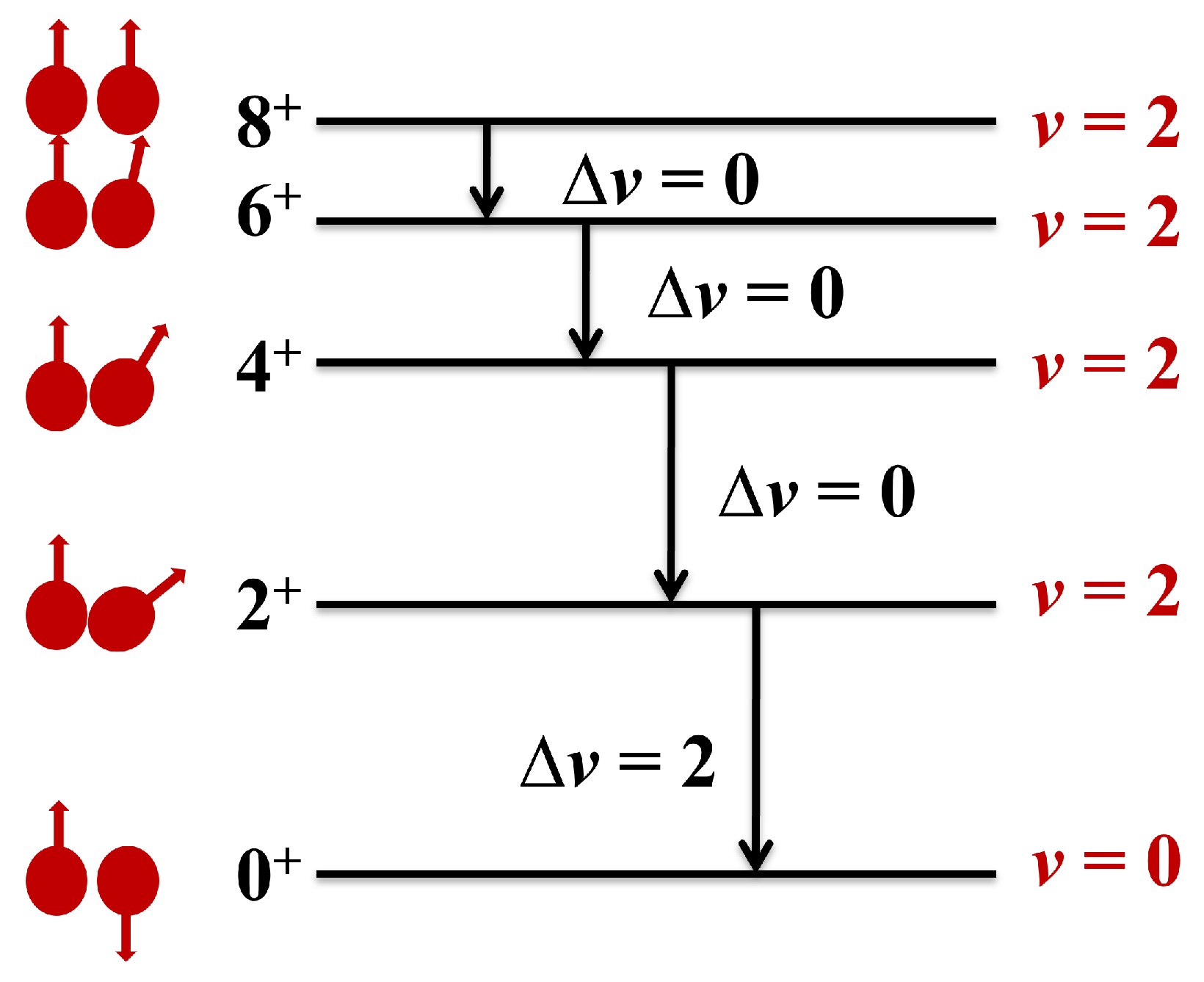
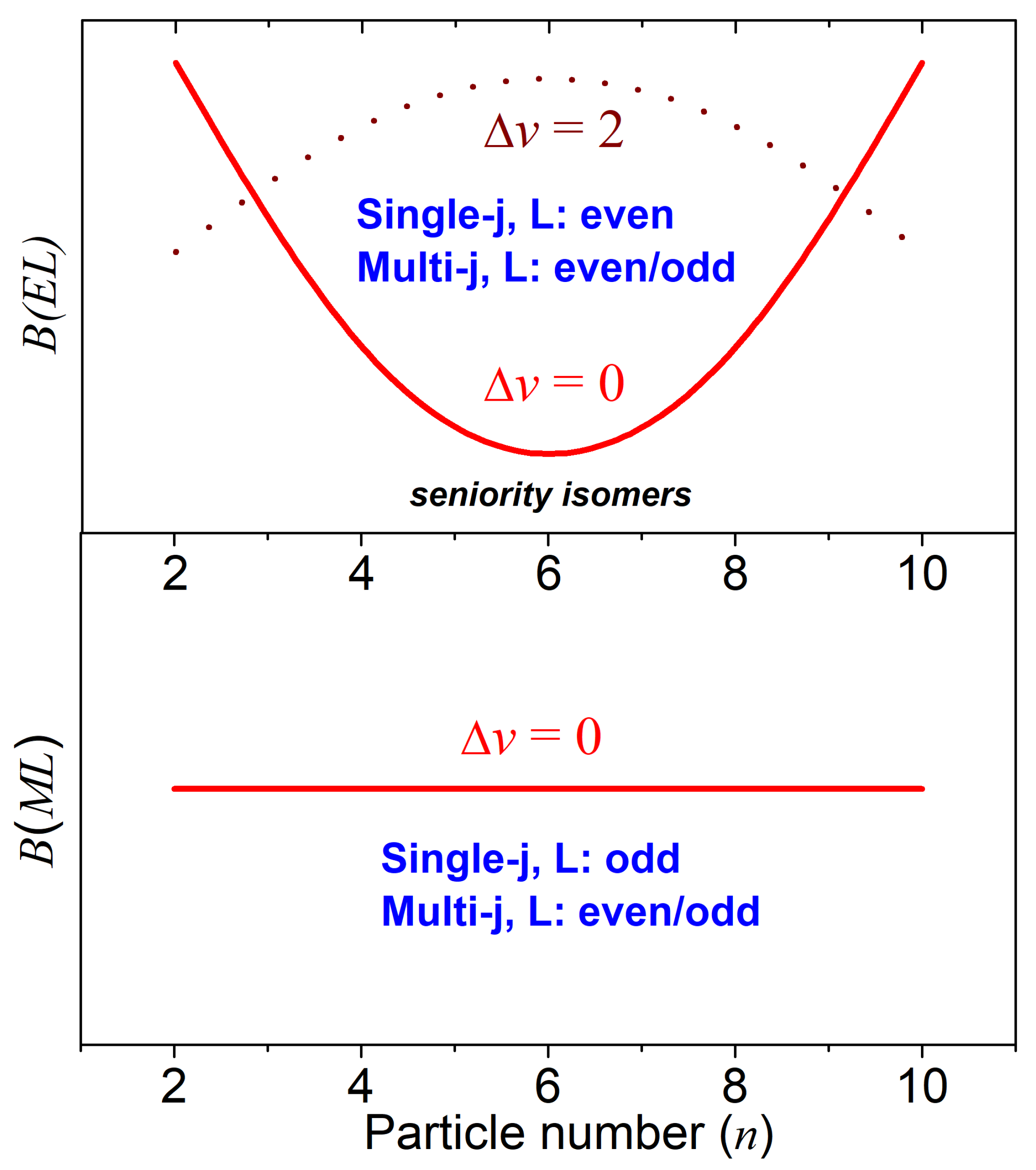
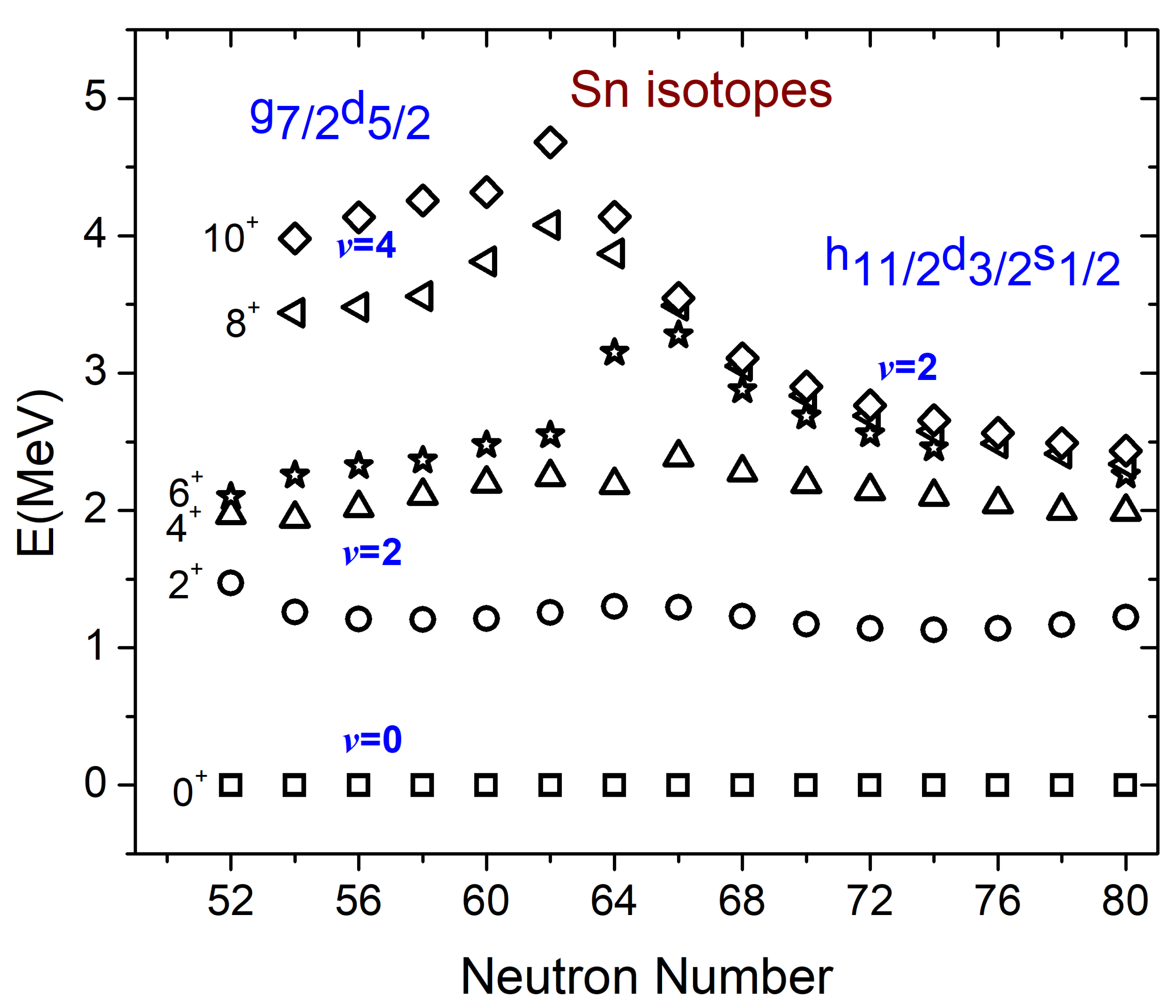
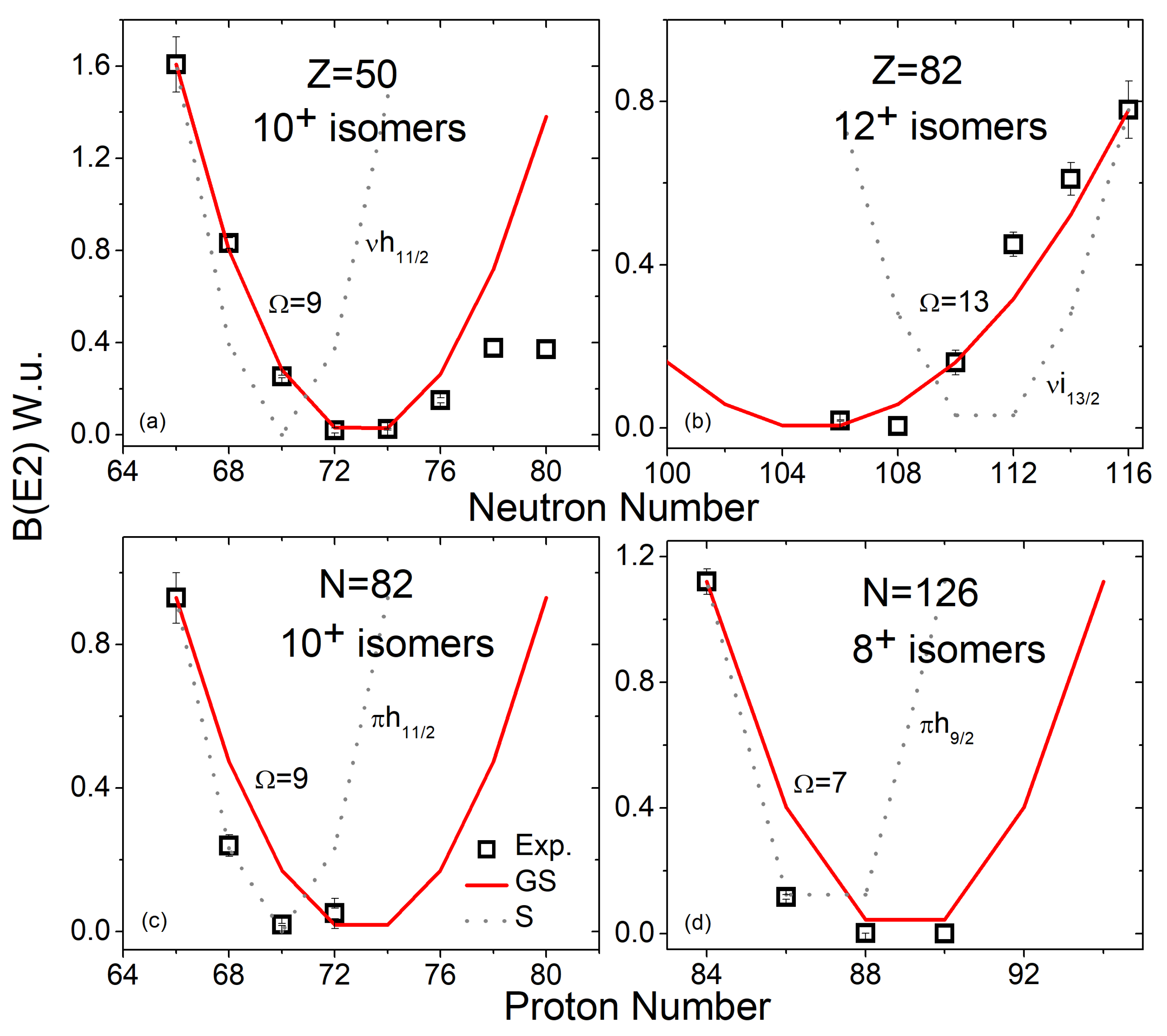

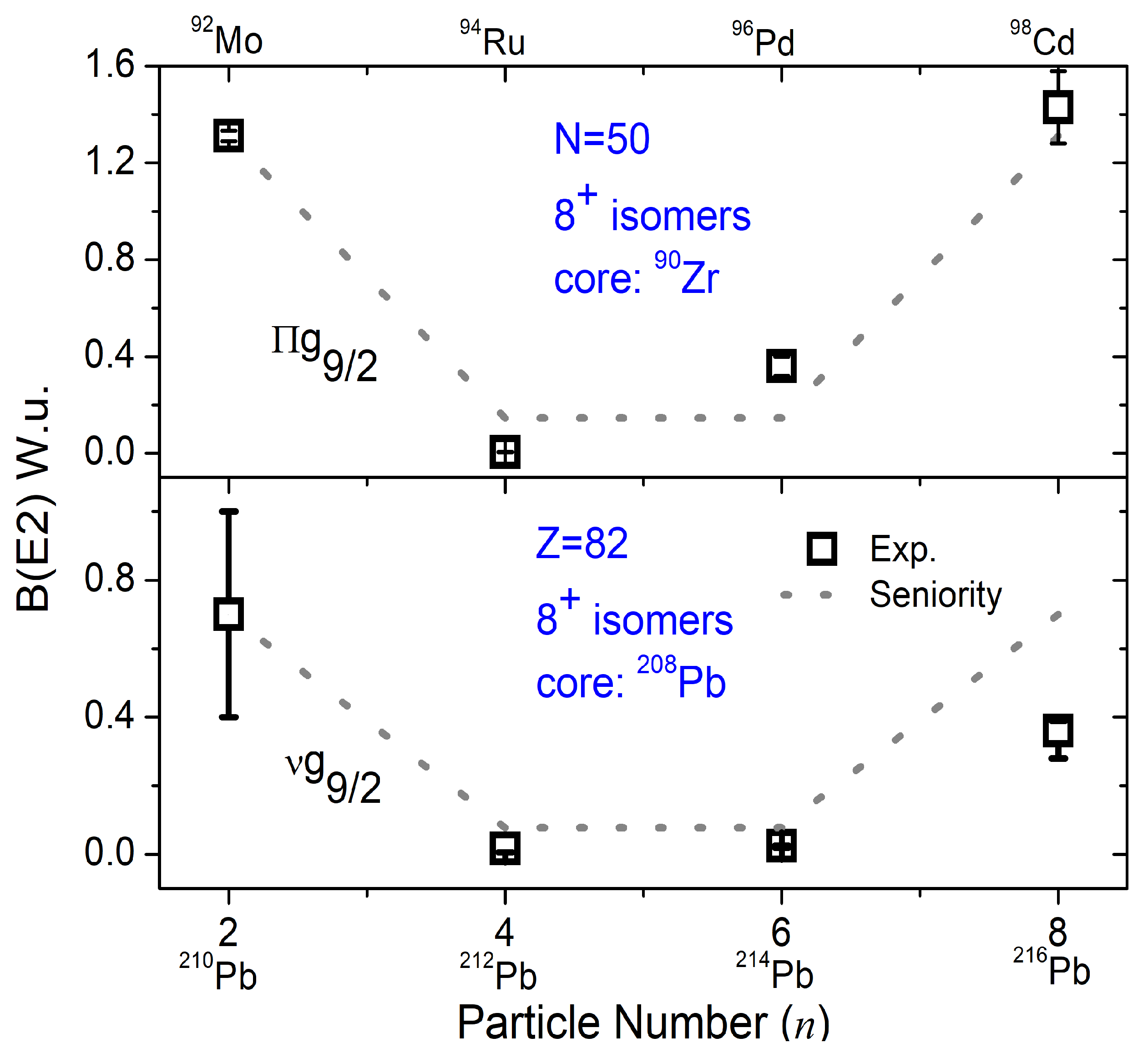
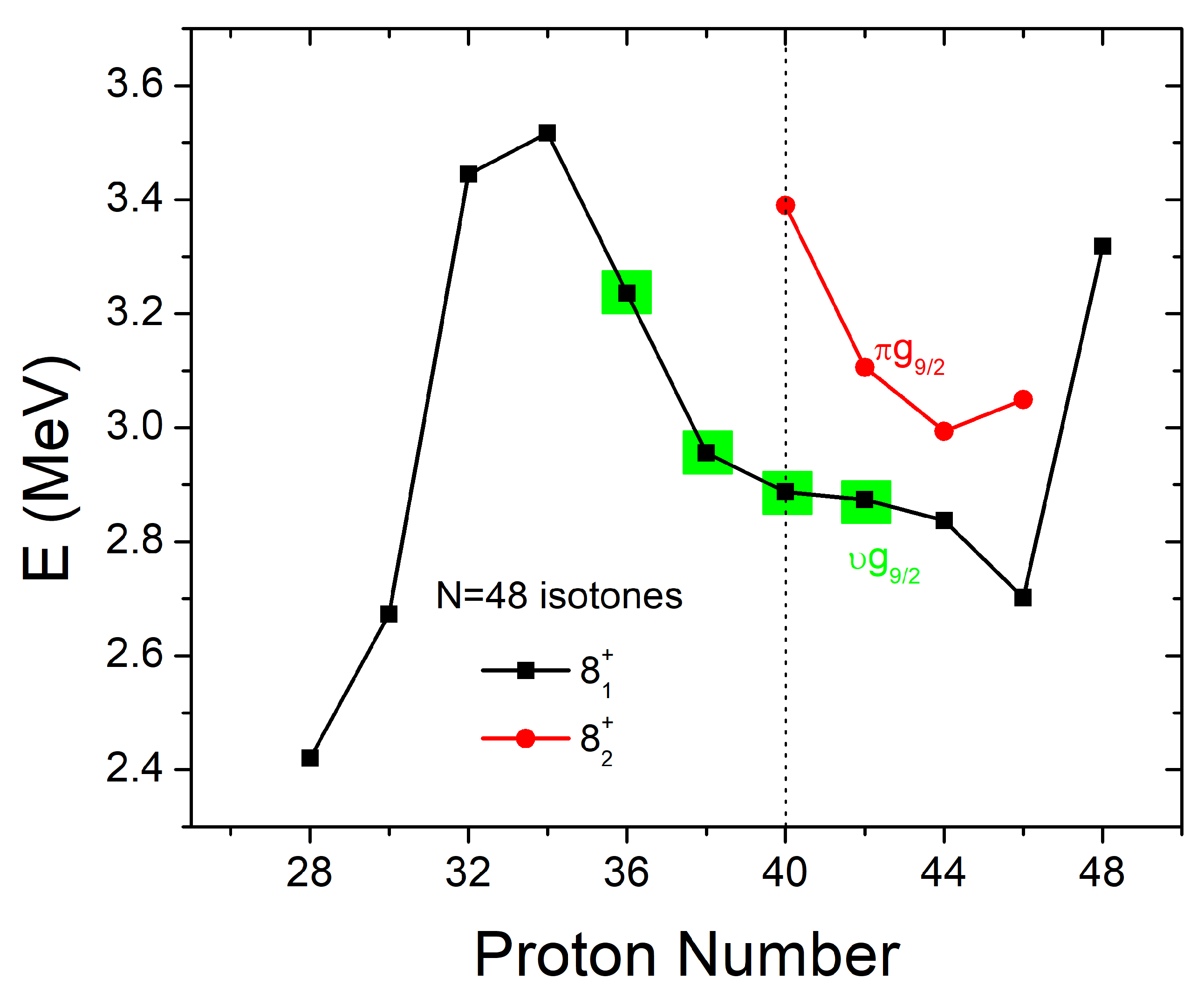
Publisher’s Note: MDPI stays neutral with regard to jurisdictional claims in published maps and institutional affiliations. |
© 2022 by the authors. Licensee MDPI, Basel, Switzerland. This article is an open access article distributed under the terms and conditions of the Creative Commons Attribution (CC BY) license (https://creativecommons.org/licenses/by/4.0/).
Share and Cite
Maheshwari, B.; Nomura, K. Overview of Seniority Isomers. Symmetry 2022, 14, 2680. https://doi.org/10.3390/sym14122680
Maheshwari B, Nomura K. Overview of Seniority Isomers. Symmetry. 2022; 14(12):2680. https://doi.org/10.3390/sym14122680
Chicago/Turabian StyleMaheshwari, Bhoomika, and Kosuke Nomura. 2022. "Overview of Seniority Isomers" Symmetry 14, no. 12: 2680. https://doi.org/10.3390/sym14122680
APA StyleMaheshwari, B., & Nomura, K. (2022). Overview of Seniority Isomers. Symmetry, 14(12), 2680. https://doi.org/10.3390/sym14122680





